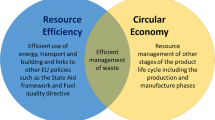Abstract
This article analyses the flow of cadmium through the Australian economy during the one-year period, 1998–1999 using material flow analysis (MFA) or substance flow analysis (SFA) as a framework. MFA/SFA can provide a holistic picture of resource use and loss through a geographic region in a specific year, allowing all material/substance inflows, outflows, and stocks through each sub-compartment in the economy to be examined. The results of the study were visualized and presented in diagrams, including an aggregate diagram of the economic system. Existing data from a large variety of sources was utilised to complete all cadmium flows within the Australian economy. Some assumptions and judgments were made in order to determine the cadmium flows in each operation and application stage. Australian cadmium sources are linked to the resources of zinc, lead, copper, iron, limestone and gypsum. A large accumulation of cadmium can result from on-site waste treatment arising from industrial facilities and household-waste landfills. Atmospheric deposition, phosphate fertilisers and animal manure have been identified as other significant inputs to agricultural soils, especially at some polluted areas near industrial facilities. The measurement, analysis and control of the cadmium flows in Australia are therefore considered on the basis of these abundant resources, certain commodities and agricultural inputs. The SFA analysis presented is a useful tool in the development of a cadmium management policy suited to the Australian economy and the receiving environment.






Similar content being viewed by others
References
ABARE (2000) Australian Commodity Statistics 2000. Commonwealth of Australia, Canberra
ABS (2001) Agriculture: land used for agriculture. ABS. http://www.abs.gov.au. Last Updated: n/a. Access: 27 December 2001
Alloway BJ (ed) (1995) Heavy metals in soils, 2nd edn. Blackie, London
ANZECC & ARMCANZ (1999) (Draft) National water quality management strategy: Australia & New Zealand guidelines for fresh and marine water quality
Baccini P, Brunner PH (1991) Metabolism of the anthroposphere. Springer, Berlin
Brunner PH, Obernosterer R (1997) MAcTEmPo-case study: urban metabolism: the city of Vienna. Report No. Vienna University of Technology, Vienna
Bureau of Resource Sciences (1997) Managing cadmium in agriculture and food: the issues for government. Bureau of Resource Sciences, Canberra
Bureau of Rural Resources (1988) In: Proceedings No.2 - cadmium accumulation in Australian agriculture. Cadmium accumulation in Australian agriculture: national symposium, Australian Government Publishing Service, Canberra
CAS (1998) Directory of Australian and New Zealand chemical manufacturers and wholesalers 1999/2000 edition. Chemical Advisory Service, Vermont, Australia
DASCEM (1997) Nickel cadmium battery waste study-phase 1 for Telstra Corporation Limited. Report No: T08/97, Melbourne
Department of Agriculture Fisheries and Forestry Australia (2001) Australian Forests and Plantations. AFFA. http://www.affa.gov.au/content/output.cfm?ObjectID=D2C48F86-BA1A-11A1-A2200060B0A03776. Last Updated: 11 September 2001. Access: 8 Jan 2001
Department of Secondary Industry (1973) A study of the Australian phosphatic fertilizer industry. Australian Government, Canberra
Dutrizac JE, Jambor JL (2000) Jarosites and their application in hydrometallurgy. In: Alpers CN, Jambor JL, Nordstrom DK (eds) Sulfate minerals: crystallography, geochemistry, and environmental significance. Mineralogical Society of America, Washington DC
Environment Australia (2000a) National Pollutant Inventory Guide. Commonwealth of Australia, Canberra
Environment Australia (2000b) National Pollutant Inventory: CD-ROM. Commonwealth of Australia
Lampert C, Brunner PH (1999) Material accounting as a policy tool for nutrient management in the Danube Basin. Water Sci Technol 40(10):43–49
Mantell CL (1975) Solid wastes: origin, collection, processing, and disposal. Wiley, New York
McGuffog D (2001) The Australian fertilizer sector. Fertilizer Focus 10–18
Mclaughlin MJ (2001) Australia’s national cadmium minimisation strategy. Fertilizers in Focus, 28–29 May 2001, Fertilizer Industry Federation of Australia, Inc
Mclaughlin MJ., Tiller KG, Naidu R, Stevens DP (1996) Review: the behaviour and environmental impact of contaminants in fertilizers. Aust J Soil Res 34:1–54
Moore S (1997) Environmental concerns and management of cadmium in Europe and Australia. In: Proceedings of Australian workshop on the collection and recycling of nickel–cadmium batteries, 8 December 1997. Canberra, Environment Australia
Morrow H, Keating J (1997) Overview paper on effective recycling of Ni–Cd batteries. In: Proceedings of the OECD workshop on the effective collection and recycling of nickel–cadmium batteries, Lyon, France, 23–25 September 1997. OECD, Lyon, pp 23–34
Nriagu JO (1989) A global assessment of natural sources of atmospheric trace metals. Nature 338(2):47–49
Nriagu JO, Pacyna JM (1988) Quantitative assessment of worldwide contamination of air, water and soils by trace metals. Nature 333(12):134–139
NSW Agriculture (1995) Soils sense: soil management for NSW north coast farmers. NSW Agriculture
Pasminco Metals-Sulphide Pty Ltd. (1998) Pasminco Metals-Sulphide: process information. Pasminco Metals-Sulphide, Sydney
Senn A, Milham P (2000) Managing cadmium in vegetables. NSW Agriculture. http://www.agric.nsw.gov.au/reader/7187#Reducing. Last Updated: 10 May 2000. Access: 25 December 2001
Swaine DJ (1990) Trace elements in coal. Butterworths, London
Swaine DJ, Goodarzi F (eds) (1995) Environmental aspects of trace elements in coal. Energy & Environment. Kluwer, Dordrecht
Van der Voet E, Van Egmond L, Kleijn R, Huppes G (1994) Cadmium in the European community: a policy-oriented analysis. Waste Manag Res 12:507–526
WHO (1992) Cadmium. World Health Organization, Geneva
WMC (2002) Chemical analysis of WMC gold, nickel and copper–uranium tailings. WMC http://www.wmc.com/sustain/environ/tailings/tailings_table1.html. Last Updated: n/a. Access: 2 Febuary 2002
Woodcock JT, Hamilton JK (eds) (1993) Australasian mining and metallurgy. The Australian Institute of Mining and Metallurgy, Victoria
World Coal Institute: 2002, Electricity generation from coal. World Coal Institute. http://www.wci-coal.com/web/list.php?menu_id=2.7.2.1. Last Updated: n/a. Access: 26 July 2002
Acknowledgments
We would like to thank Dr. Hans-Peter Bader and Ruth Scheidegger at the Swiss Federal Institute of Aquatic Science and Technology for their advice and encouragements, for reading the manuscript and for their helpful comments.
Author information
Authors and Affiliations
Corresponding author
Rights and permissions
About this article
Cite this article
Kwonpongsagoon, S., Waite, D.T., Moore, S.J. et al. A substance flow analysis in the southern hemisphere: cadmium in the Australian economy. Clean Techn Environ Policy 9, 175–187 (2007). https://doi.org/10.1007/s10098-006-0078-z
Received:
Accepted:
Published:
Issue Date:
DOI: https://doi.org/10.1007/s10098-006-0078-z




